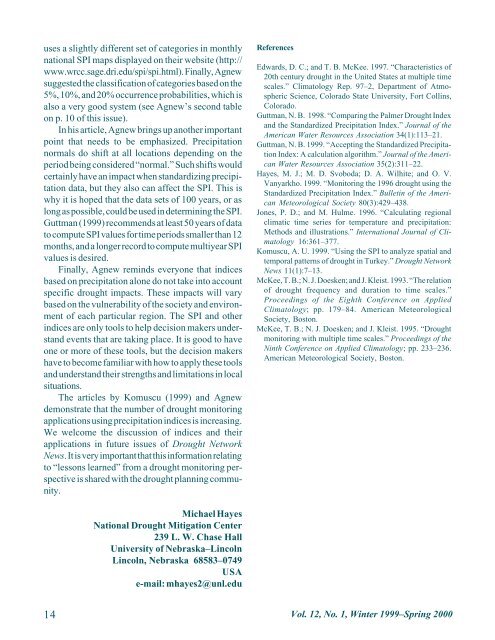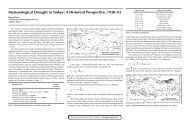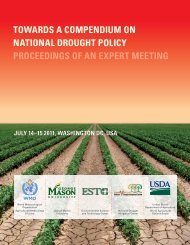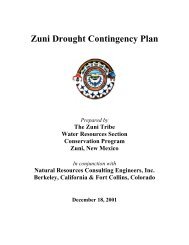uses a slightly different set of categories in monthlynational SPI maps displayed on <strong>the</strong>ir website (http://www.wrcc.sage.dri.edu/spi/spi.html). Finally, Agnewsuggested <strong>the</strong> classification of categories based on <strong>the</strong>5%, 10%, and 20% occurrence probabilities, which isalso a very good system (see Agnew’s second tableon p. 10 of this issue).In his article, Agnew brings up ano<strong>the</strong>r importantpoint that needs to be emphasized. Precipitationnormals do shift at all locations depending on <strong>the</strong>period being considered “normal.” Such shifts wouldcertainly have an impact when standardizing precipitationdata, but <strong>the</strong>y also can affect <strong>the</strong> SPI. This iswhy it is hoped that <strong>the</strong> data sets of 100 years, or aslong as possible, could be used in determining <strong>the</strong> SPI.Guttman (1999) recommends at least 50 years of datato compute SPI values for time periods smaller than 12months, and a longer record to compute multiyear SPIvalues is desired.Finally, Agnew reminds everyone that indicesbased on precipitation alone do not take into accountspecific drought impacts. These impacts will varybased on <strong>the</strong> vulnerability of <strong>the</strong> society and environmentof each particular region. The SPI and o<strong>the</strong>rindices are only tools to help decision makers understandevents that are taking place. It is good to haveone or more of <strong>the</strong>se tools, but <strong>the</strong> decision makershave to become familiar with how to apply <strong>the</strong>se toolsand understand <strong>the</strong>ir strengths and limitations in localsituations.The articles by Komuscu (1999) and Agnewdemonstrate that <strong>the</strong> number of drought monitoringapplications using precipitation indices is increasing.We welcome <strong>the</strong> discussion of indices and <strong>the</strong>irapplications in future issues of <strong>Drought</strong> NetworkNews. It is very important that this information relatingto “lessons learned” from a drought monitoring perspectiveis shared with <strong>the</strong> drought planning community.ReferencesEdwards, D. C.; and T. B. McKee. 1997. “Characteristics of20th century drought in <strong>the</strong> United States at multiple timescales.” Climatology Rep. 97–2, Department of AtmosphericScience, Colorado State University, Fort Collins,Colorado.Guttman, N. B. 1998. “Comparing <strong>the</strong> Palmer <strong>Drought</strong> Indexand <strong>the</strong> Standardized Precipitation Index.” Journal of <strong>the</strong>American Water Resources Association 34(1):113–21.Guttman, N. B. 1999. “Accepting <strong>the</strong> Standardized PrecipitationIndex: A calculation algorithm.” Journal of <strong>the</strong> AmericanWater Resources Association 35(2):311–22.Hayes, M. J.; M. D. Svoboda; D. A. Wilhite; and O. V.Vanyarkho. 1999. “Monitoring <strong>the</strong> 1996 drought using <strong>the</strong>Standardized Precipitation Index.” Bulletin of <strong>the</strong> AmericanMeteorological Society 80(3):429–438.Jones, P. D.; and M. Hulme. 1996. “Calculating regionalclimatic time series for temperature and precipitation:Methods and illustrations.” International Journal of Climatology16:361–377.Komuscu, A. U. 1999. “Using <strong>the</strong> SPI to analyze spatial andtemporal patterns of drought in Turkey.” <strong>Drought</strong> NetworkNews 11(1):7–13.McKee, T. B.; N. J. Doesken; and J. Kleist. 1993. “The relationof drought frequency and duration to time scales.”Proceedings of <strong>the</strong> Eighth Conference on AppliedClimatology; pp. 179–84. American MeteorologicalSociety, Boston.McKee, T. B.; N. J. Doesken; and J. Kleist. 1995. “<strong>Drought</strong>monitoring with multiple time scales.” Proceedings of <strong>the</strong>Ninth Conference on Applied Climatology; pp. 233–236.American Meteorological Society, Boston.Michael Hayes<strong>National</strong> <strong>Drought</strong> <strong>Mitigation</strong> <strong>Center</strong>239 L. W. Chase HallUniversity of Nebraska–LincolnLincoln, Nebraska 68583–0749USAe-mail: mhayes2@unl.edu14 Vol. 12, No. 1, Winter 1999–Spring 2000
An Introduction to <strong>the</strong> <strong>Drought</strong> MonitorOriginsThe idea of better monitoring and assessing droughthas been a quest of NDMC director Don Wilhite formore than two decades. He has been an advocate ofbetter climate monitoring, particularly drought monitoring,because drought is a normal, recurring hazardin virtually all of <strong>the</strong> United States. The challenge isto recognize drought, a slow-onset or “creeping”natural disaster, before a region is in <strong>the</strong> middle ofone.The most recent surge in interest in drought aroseduring <strong>the</strong> 1995–96 drought in <strong>the</strong> Southwest andsou<strong>the</strong>rn Great Plains states. At <strong>the</strong> NDMC wediscussed how we could do a better job of trackingand assessing <strong>the</strong> severity of droughts. One questionwe often hear is “How does this drought compare, orrank, to o<strong>the</strong>r droughts or <strong>the</strong> drought of record forthis region or state?” Or “Just how strong or severe isthis drought?” These are complicated questions totackle. We have to take into account spatial extent,intensity, duration, and impacts on people and <strong>the</strong>affected environment. That discussion is for ano<strong>the</strong>rtime.For purposes of understanding vulnerability orrisk, ano<strong>the</strong>r question we have tried to address is“What is <strong>the</strong> degree of usualness or unusualness ofvarious droughts now and in <strong>the</strong> past?” How frequentlyor rarely do we see a drought of this magnitude,and does it occur often enough that we shouldplan for it ra<strong>the</strong>r than simply ac<strong>know</strong>ledge it when itoccurs? In short, can we define <strong>the</strong> difference betweenperception and reality? Our hope is that <strong>the</strong><strong>Drought</strong> Monitor and future research will begin to letus find some of <strong>the</strong> answers to <strong>the</strong>se questions.Until recently, <strong>the</strong>re were no comprehensive nationwideefforts to consolidate or centralize droughtmonitoring activities being conducted by or betweenvarious federal, state, or regional entities. In <strong>the</strong>summer of 1998, I began to correspond with DougLeComte, senior meteorologist with <strong>the</strong> <strong>National</strong><strong>Center</strong>s for Environmental Prediction/Climate Prediction<strong>Center</strong> (NCEP/CPC), who shared his ideaswith us on how we might come up with a classificationsystem for droughts, much in <strong>the</strong> same way <strong>the</strong>Fujita Tornado Intensity Scale (F0–F5) categorizestornadoes and <strong>the</strong> Saffir-Simpson Hurricane System(Category 1–5) rates hurricane strength. Based onLeComte’s first draft, and with <strong>the</strong> help of o<strong>the</strong>rs, weworked on a classification scheme criteria, and as aresult <strong>the</strong> <strong>Drought</strong> Monitor was created.In spring 1999, Don Wilhite and I met withscientists at <strong>the</strong> U.S. Department of Agriculture’sJoint Agricultural Wea<strong>the</strong>r Facility (USDA/JAWF)and <strong>the</strong> <strong>National</strong> Oceanic and AtmosphericAdministration’s Climate Prediction <strong>Center</strong> (NOAA/CPC) to discuss working toge<strong>the</strong>r to address <strong>the</strong> issueof tracking drought. How could we better collaborateand implement an integrated drought monitoringsystem? The signing of <strong>the</strong> <strong>National</strong> <strong>Drought</strong> PolicyAct in <strong>the</strong> summer of 1998 and <strong>the</strong> subsequentformation of <strong>the</strong> <strong>National</strong> <strong>Drought</strong> Policy Commission(NDPC) and its working groups in 1999 nodoubt helped speed up <strong>the</strong> process and fueled interestin such an effort. Monitoring and Prediction was oneof <strong>the</strong> NDPC working groups. Many of <strong>the</strong> keyplayers in <strong>the</strong> climate monitoring realm were exposedto <strong>the</strong> <strong>Drought</strong> Monitor concept and initial prototypesthrough this working group. We introduced <strong>the</strong>drought classification system to <strong>the</strong>m and welcomed<strong>the</strong> many suggestions that followed in this informalpeer review process.As a result of <strong>the</strong> meetings in spring 1999, anagreement was reached between <strong>the</strong> NDMC, USDA,and NOAA to produce and maintain a drought monitoringproduct that would incorporate climatic dataand professional input from all levels. Requests forinput were initially sent out to <strong>National</strong> Wea<strong>the</strong>rService field offices. This was followed up by contactingNOAA’s six regional climate centers (RCCs).We have invited state climatologists to comment onand review <strong>the</strong> weekly product (both map and narrative).Our intent was to create a general assessment ofdrought conditions in <strong>the</strong> United States using <strong>the</strong> most<strong>Drought</strong> Network News15








